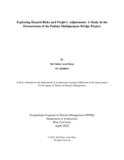| dc.contributor.advisor | Kabir, Md. Humayun | |
| dc.contributor.author | Khan, Md Fahim Azraf | |
| dc.date.accessioned | 2022-09-13T10:16:38Z | |
| dc.date.available | 2022-09-13T10:16:38Z | |
| dc.date.copyright | 2022 | |
| dc.date.issued | 2022-04 | |
| dc.identifier.other | ID: 20268015 | |
| dc.identifier.uri | http://hdl.handle.net/10361/17214 | |
| dc.description | This dissertation is submitted in partial fulfillment of the requirements for the degree of Master in Disaster Management, 2022. | en_US |
| dc.description | Cataloged from PDF version of dissertation. | |
| dc.description | Includes bibliographical references (pages 45-47). | |
| dc.description.abstract | The development induced hazards (i.e. erosion) has become a matter of great concern in recent
years. The Padma Multipurpose Bridge Project is going to be one of the biggest infrastructures in
Bangladesh and is estimated to increase the annual growth by more than 1.0 per cent. But large
development projects have some demerits too. Due to this massive construction process, the
normal channel of the river has been altered and it has resulted significant erosion in the
downstream of the Padma river. So a study has been undertaken to understand the hazard risk of
the Uria Village which is situated at the downstream of the Padma river in Louhajang upazila. To
investigate the changed social and economic status and the coping strategies of the people living
in the area, a questionnaire survey has been done on 113 households. Moreover, change of land
use pattern of the area has been determined using Landset. Finally, an overall comparison has been
done on the present livelihood, economic status and condition of the houses of the households with
the state before beginning of the construction of the Padma Multipurpose Bridge. It has been found
that, water bodies have been decreased to a great extent but build up area has been increased almost
8 times between 2000 and 2020. The agricultural lands also decreased from 91134.8 acres to
15335.34 acres in the mentioned period. Due to erosions specially in the downstrem, these lands
have been engulfed by the Padma river. On the other hand, 74 out of 100 people lost their lands
where they used to live or cultivate. Only 15% of them have been able to find new jobs and
livelihood. To adopt with the condition, 66% respondents are planning to relocate themselves to
nearby villages or cities like Holudia, Madaripur, Goalibanda, Srinagar etc. which are situated in
comparatively highlands. It has been recommended to provide small interest-free loans to the
affected people from the administration so that they can adopted with the shocks of disasters and
build new temporary houses to live in. Along the shore of the Padma, plantation of this Vetiver
grass can mitigate the rate of erosion as well. Finally, after the end of construction, the current
location of the Shimula Ghat should be changed as it has accelerated the rate of the erosion in the
downstream. | en_US |
| dc.description.statementofresponsibility | Md Fahim Azraf Khan | |
| dc.format.extent | 47 Pages | |
| dc.publisher | Brac University | en_US |
| dc.rights | BRAC University dissertations are protected by copyright. They may be viewed from this source for any purpose, but reproduction or distribution in any format is prohibited without written permission. | |
| dc.subject | Hazard Risks | en_US |
| dc.subject | People’s Adjustment | en_US |
| dc.subject | Downstream | en_US |
| dc.subject | Padma Multipurpose Bridge Project | en_US |
| dc.subject.lcsh | Padma Bridge (Bangladesh) | |
| dc.subject.lcsh | Railroad bridges--Bangladesh. | |
| dc.title | Exploring Hazard Risks and People’s Adjustment: A Study in the Downstream of the Padma Multipurpose Bridge Project | en_US |
| dc.type | Thesis | en_US |
| dc.contributor.department | Department of Architecture, BRAC University | |
| dc.description.degree | M. Disaster Management | |

